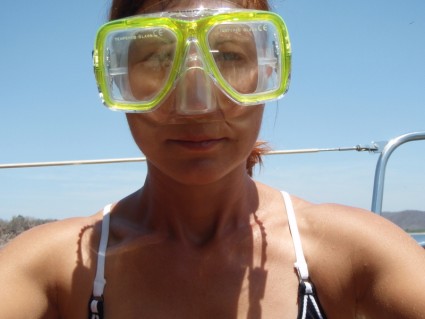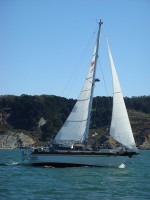
The Cruise of Mariposa
24 November 2009 | Fondeadero San Carlos, Baja California Norte, Mexico
20 November 2009 | Turtle Bay, Baja California Sur, Mexico
19 November 2009 | Bahia Asuncion, Baja California Sur, Mexico
18 November 2009 | Punta Abreojos, Baja California Sur, Mexico
02 November 2009 | Bahia los Frailes, Baja California Sur, Mexico
01 November 2009 | Ensenada de los Muertos, Baja California Sur
30 October 2009 | Playa Pichilingue, Baja California Sur, Mexico
30 October 2009 | La Paz, Baja California Sur, Mexico
16 September 2009 | Puerto Escondido, BCS, Mexico
04 September 2009 | Puerto Escondido, BCS, Mexico
03 September 2009 | Puerto Escondido, BCS, Mexico
31 August 2009 | Puerto Escondido, Baja California Sur, Mexico
31 August 2009 | Puerto Escondido, Baja California Sur, Mexico
09 July 2009 | Puerto Los Gato, Baja California Sur, Mexico
07 July 2009 | San Evaristo, Baja California Sur, Mexico
04 July 2009 | Ensenada Grande, Isla Partida, Baja California Sur, Mexico
30 June 2009 | Southern Baja
22 June 2009 | Mazatlan, Sinaloa, Mexico
19 June 2009 | La Ventana, Baja California Sur, Mexico
19 June 2009 | Puerto Ballandra, Baja California Sur, Mexico
Tenecatita
10 April 2009 | Tenecatita Bay, Jalisco, Mexico
Sarka/Warm and windy

This part of the Mexican Riviera, the stretch between Puerto Vallarta and Manzanillo, is quite a treat for boat cruisers because its coast forms a number of bays and anchorages. Though varying in size and texture, they are suitable for a restful stay in most weather conditions, and are well within a day of sailing from one to another. Chamela Bay is distant from Tenacatita ("Ten Bay" as lazy white people call it) only some 28 miles. We had wonderful sailing conditions all the way there, and used the engine only to maneuver into and out of anchorages.
The north end of Tenacatita Bay is divided into two lobes by a projecting cape forming an inner and an outer cove. The cove further in offers more protection from wind and ocean swell, and so is a better and more popular anchorage. When we reached it in the early evening on April 4th, there were a dozen other boats gently bobbing in unison. We anchored in a sweet little side nook of the anchorage. Egrets were busily surveying the shore, and we felt cozy as if in an untouched and private spot of our own.
Tenacatita is notorious for difficult dinghy landings; we had been warned to "always wear a swimming suit" when going to the shore. The long beach here slopes into the water at a very gentle grade. This makes the water shallow for quite a distance, which in turn makes the breaking waves more turbulent. To a small dinghy this presents a two-fold difficulty: there is not enough water to leave the outboard motor engaged for a brisk transit over the shallow stretch between waves, while the breaking surf is long, high and tumultuous. Getting to shore, with the water flowing in the same direction and in an unburdened dinghy is usually much easier than going from shore against the waves, with a dinghy full of provisions. We made two landings on that beach. Our rowing was well enough timed that we did not get soaked going in, but leaving the shore, it seemed wiser to walk the dinghy out into the calmer waters. This essentially meant going for a swim in the company of our dinghy.
At the anchorage end of the inner cove there is a 2-1/2 mile river estuary, a narrow waterway through the mangroves. Near the anchorage is a favorite campground for Mexican families, but there is no town. Twice we maneuvered our dinghy over the reef entrance and up the river, through beautiful narrow tunnels of lush mangrove plants. At the end of the river is a lagoon and a little beach, and beyond the beach is the outer cove of Tenecatita Bay. The "town," more of a patchwork of beach restaurants and souvenir stands, stretches along the outer cove. We ate fish with our toes in the sand and bought groceries and water from the little shops.
In these tropical waters, and particularly as a result of sitting in the fetid waters of the La Cruz marina for a month, our hull became quite a menagerie of sea critters. Not only were they plainly visible to the naked eye, they noticeably hampered our progress through water. Eric and I divided the task of cleaning the hull up. He did the underwater portion, and I, on account of being inexperienced with the snorkel (wussy), did the water-line (not many barnacles there). Eric, although he said he enjoyed the task, the water was murky and unseasonally cold (around 70 degrees rather than the 80s we deserve), and he would emerge from it shivering, a little deaf, with remnants of the menagerie in his hair. After three days of diving and scraping, he pronounced the hull clean.
One afternoon we inadvertently sucked up a very small squid into the head plumbing. Poor fella did not survive the ride.
On another occasion I decided to bake a loaf of challah, and thanks to the low gluten content in Mexican flour and to the absence of the refrigeration required by the recipe, we were almost chased out of our living quarters by the rising dough.
We stayed in Tenacatita for almost a week and would have enjoyed staying there a little longer, but it was Eric's dad's birthday the next day, and we needed to be closer to lines of communication with the world. So off we went, to Barra de Navidad.
The north end of Tenacatita Bay is divided into two lobes by a projecting cape forming an inner and an outer cove. The cove further in offers more protection from wind and ocean swell, and so is a better and more popular anchorage. When we reached it in the early evening on April 4th, there were a dozen other boats gently bobbing in unison. We anchored in a sweet little side nook of the anchorage. Egrets were busily surveying the shore, and we felt cozy as if in an untouched and private spot of our own.
Tenacatita is notorious for difficult dinghy landings; we had been warned to "always wear a swimming suit" when going to the shore. The long beach here slopes into the water at a very gentle grade. This makes the water shallow for quite a distance, which in turn makes the breaking waves more turbulent. To a small dinghy this presents a two-fold difficulty: there is not enough water to leave the outboard motor engaged for a brisk transit over the shallow stretch between waves, while the breaking surf is long, high and tumultuous. Getting to shore, with the water flowing in the same direction and in an unburdened dinghy is usually much easier than going from shore against the waves, with a dinghy full of provisions. We made two landings on that beach. Our rowing was well enough timed that we did not get soaked going in, but leaving the shore, it seemed wiser to walk the dinghy out into the calmer waters. This essentially meant going for a swim in the company of our dinghy.
At the anchorage end of the inner cove there is a 2-1/2 mile river estuary, a narrow waterway through the mangroves. Near the anchorage is a favorite campground for Mexican families, but there is no town. Twice we maneuvered our dinghy over the reef entrance and up the river, through beautiful narrow tunnels of lush mangrove plants. At the end of the river is a lagoon and a little beach, and beyond the beach is the outer cove of Tenecatita Bay. The "town," more of a patchwork of beach restaurants and souvenir stands, stretches along the outer cove. We ate fish with our toes in the sand and bought groceries and water from the little shops.
In these tropical waters, and particularly as a result of sitting in the fetid waters of the La Cruz marina for a month, our hull became quite a menagerie of sea critters. Not only were they plainly visible to the naked eye, they noticeably hampered our progress through water. Eric and I divided the task of cleaning the hull up. He did the underwater portion, and I, on account of being inexperienced with the snorkel (wussy), did the water-line (not many barnacles there). Eric, although he said he enjoyed the task, the water was murky and unseasonally cold (around 70 degrees rather than the 80s we deserve), and he would emerge from it shivering, a little deaf, with remnants of the menagerie in his hair. After three days of diving and scraping, he pronounced the hull clean.
One afternoon we inadvertently sucked up a very small squid into the head plumbing. Poor fella did not survive the ride.
On another occasion I decided to bake a loaf of challah, and thanks to the low gluten content in Mexican flour and to the absence of the refrigeration required by the recipe, we were almost chased out of our living quarters by the rising dough.
We stayed in Tenacatita for almost a week and would have enjoyed staying there a little longer, but it was Eric's dad's birthday the next day, and we needed to be closer to lines of communication with the world. So off we went, to Barra de Navidad.
Comments
| Vessel Name: | Mariposa |
| Vessel Make/Model: | 1979 Ta Shing Baba 30 |
| Hailing Port: | San Francisco, CA |
| Crew: | Sarka & Eric |
| About: | Sarka and Eric are on a 12-18 month trip to Mexico and the South Pacific. |
Gallery not available

Who: Sarka & Eric
Port: San Francisco, CA
